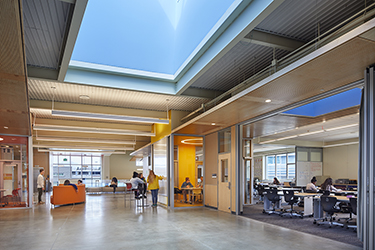|
Subscribe / Renew |
|
|
Contact Us |
|
| ► Subscribe to our Free Weekly Newsletter | |
| home | Welcome, sign in or click here to subscribe. | login |
Construction
| |
 |
August 30, 2018
Studies suggest design really can affect how well students learn
NAC Architecture

Riedel
|

Mahoe
|
Environmental psychology is the interdisciplinary study of how our surroundings shape our behavior, mindset and performance.
The principles of environmental psychology have been applied to numerous settings, including work environments, retail spaces and health care facilities. As architects dedicated to creating next-generation learning spaces, we believe that the approach to designing educational environments has a lot of potential to benefit from this field.
While increasing evidence points to the correlation between the physical environment and academic success, studying the effects of environments on learning is notoriously difficult due to the variety of factors that affect learning outcomes for each student. That being said, scholars continue to study this relationship in order to further understand how a building can affect learning.
What research says
Recently, researchers at the University of Melbourne in Australia reviewed thousands of articles searching for evidence of environmental effects on learning outcomes. Through this examination, they determined that “emerging evidence shows a trend that spatial design does positively impact student learning outcomes.” (Read the report online at http://bit.ly/2ME8ywO.)
While admitting that the evidence is limited and more research is needed, University of Melbourne researchers found several studies in the last decade that show spatial factors account for a significant portion of the variance in learning outcomes.
These results affirm the findings of a previous study from the University of Salford in England, which support the idea that students in “innovative learning environments” significantly outperformed their peers in traditional schools.
The study grouped environmental factors into three categories, and identified which were found to be significantly influential:
• Naturalness: light, air quality, temperature, acoustics, links to nature
• Individualization: flexibility, ownership, connection
• Stimulation: complexity, color
High-performance building design (lighting, acoustics, air quality, etc.) accounted for 10 to 16 percent of the variance in student academic scores. Also, blended learning environments, which combine advances in technology with traditional teaching, account for a statistically significant improvement in scores.
So how can the results from these studies be applied by architects and planners interested in evidence-based design? NAC Architecture has had the opportunity to incorporate many of these design elements that have been found to support better learning outcomes in our recent pre-K-12 projects.
Links to nature
At Bellevue School District’s Bennett Elementary, abundant daylighting is provided throughout the school, particularly in learning spaces such as the library, classrooms and shared areas. Sunshades help avoid direct sunlight and reduce glare on the south side of the building.
The LED light fixtures automatically dim when daylight is sufficient. Operable windows in classrooms are combined with a ground-source heat exchange system for great indoor-air quality and temperature control.
All classrooms and shared areas have views to exterior green spaces, including courtyards and green roofs. Outside play areas take advantage of the site’s terraced hillside and existing trees, creating a strong link to nature.
Personalized spaces
The new academic building at Tacoma’s Wilson High School features general classrooms, a culinary lab and a media classroom with a TV studio, all within a highly adaptable, collaborative environment.
A variety of learning spaces support flexibility and customization, including informal shared areas, classrooms that can be combined and/or opened to shared areas with operable partitions, a large learning stair and small conference rooms for focused group work.
Students feel ownership of the space when they utilize white-board walls, personalize the art gallery and pin-up display areas, and arrange the flexible furniture for impromptu discussions. Connections among these different spaces are enhanced by wide, shared learning areas with soft seating and clear sightlines.
Visual stimulation
The Salford study determined that the benefits of environmental stimulation form a curve.
While both the most complex and least complex environments create poor learning conditions, an intermediate level of complexity is optimal. Similarly, the study found that a mid-level of color benefits learning — present, but not too strong.
At the Lake Stevens School District’s new Early Learning Center, varying levels of visual stimulation were incorporated throughout the building.
An abstract tree made from wood slats and accents of colored glass at the lobby introduce visual complexity as students enter. However, this complexity is reduced in the classroom wings, which have soft textures and some curved walls and ceiling elements in the shared areas.
The colors in these learning areas are rich, but not overly bright.
Best practices
It is worth noting that all of the studies cited above mention the need for additional research. Even so, when taken together the findings provide actionable evidence that can inform our designs.
As we have seen in our own experience, the Pacific Northwest school design community understands many of the elements highlighted in this research as effective, considering them to be best practices for creating educational facilities.
It is useful to see the percentages associated with their impact, particularly when budget or schedule implications require choices to be made. Informed with this data, school designers can help their clients make the best decisions to provide optimal learning environments for students.
Philip Riedel is a principal at NAC Architecture and president of the Association for Learning Environments, Pacific Northwest Region. Alyson Mahoe is a member of NAC’s Research & Experience Development team.
Other Stories:
- It's much easier for schools to get to net zero
- How enviro consultants can lend your school project a helping hand
- UW Life Sciences Building: giant firs and bird songs offer a one-of-a-kind elevator ride
- 3 keys to building green schools: design, operations and renewables
- Bremerton alternative school breaks down walls to learning
- The view from inside a school: what really makes it safe
- Eastside Prep’s versatile arts hall made for concerts, plays and yoga
- After two decades, UW’s SLU campus nears completion
- How playgrounds make all children feel welcome
- See-through schools spark interest in learning
- Schools have more ways than ever to go green
- OSU football center opts for flexible lighting scheme
- Stretch your tight budget by getting creative
- Long-distance teams worked in concert to remake Wyoming school theater



